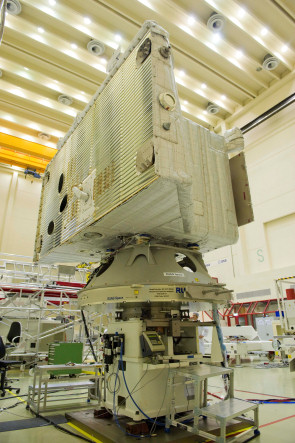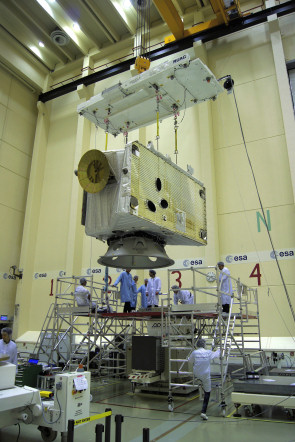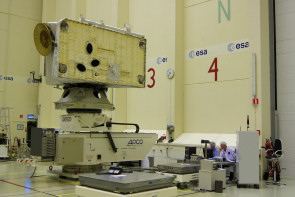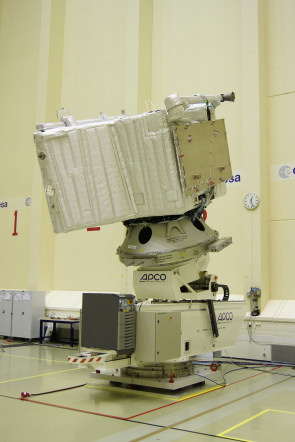#06: BepiColombo Mercury Planetary Orbiter Mass Properties Measurements
20 June 2012
The mass properties of the BepiColombo Mercury Planetary Orbiter have been measured using specialist equipment in ESA's European Space Research and Technology Centre (ESTEC).The mass properties of a spacecraft (total mass, centre of gravity [CoG] and moment of inertia [MoI] about all three axes) are among the characteristics calculated during the design process. Since the correct control and guidance of the spacecraft depend on an accurate knowledge of these values, they are subsequently measured as part of the test campaign.
 |
 |
|
BepiColombo Mercury Planetary Orbiter on the WM50/6 test system. Credit: ESA/Anneke Le'Floch |
BepiColombo Mercury Planetary Orbiter being lowered onto the M80/MPMA test system. |
The Mercury Planetary Orbiter (MPO) is the second of the mission components to have its mass properties measured at ESTEC. The Magnetospheric Orbiter Sunshield and Interface Structure (MOSIF) mass properties measurements were performed in November 2011. The mechanical properties of the Mercury Magnetospheric Orbiter (MMO) have been measured and analysed by the Japan Aerospace Exploration Agency (JAXA), which is responsible for this component of the mission. During the coming weeks, the Mercury Composite Spacecraft (MCS) will be tested at ESTEC. The MCS is made up of the MPO, the MMO, the Magnetospheric Orbiter Sunshield and Interface Structure (MOSIF), which provides the interface between the MMO and the MPO and shields the MMO from the Sun during the interplanetary journey, and the Mercury Transfer Module (MTM), whose primary task is to provide propulsion and attitude control for the journey to Mercury.
The mass properties of the MCS will be important for the mission launch, injection into the interplanetary transfer orbit and attitude control during the transfer phase. Mass properties measurement data for the MCS and for each mission element will be used also to verify compliance with launcher requirements and the kinematic behaviour of the various elements during separation. Once the MTM has separated – early enough in the planetary arrival phase to avoid it being weakly captured by Mercury's gravity – the mass properties of the MPO/MOSIF/MMO composite will be needed to refine the control algorithms used as the MPO takes over responsibility for attitude and orbit control and uses its main thrusters to perform five apocentre lowering manoeuvres. Once the MOSIF has been jettisoned and the MMO is in its orbit, the MPO will perform a number of insertion manoeuvres to reach its orbit. The mass properties of the MPO will determine the performance of the thrusters and reaction wheels that will control the attitude and orbit of the spacecraft for the rest of the mission.
MPO testing – lateral CoG and longitudinal MoI
Having been transferred to the 'Hydra' cleanroom in the ESTEC Test Centre, in early May 2012, the MPO and its Lower Handling Adapter (LHA) were lifted off of the Multi-Purpose Trolley (MPT – a ground handling trolley) by an overhead crane using a special lifting adapter. The MPO/LHA assembly was transferred to the WM50/6 test system, where the MPO Physical Properties Adapter (PPA) – a circular plate that connects the LHA to the mechanical interface of the WM50/6 – had already been installed.
The WM50/6 was used to measure the position of the spacecraft CoG along the lateral (horizontal, in this configuration) axes and the MoI about the longitudinal (vertical) axis. The essential element of the facility is a rigid table resting on two knives. The two knives define a horizontal axis, which is the facility's zero reference for CoG measurement. A load cell inside the machine measures the static imbalance introduced on the table when the test object is installed. Knowing the test article measured mass and the imbalance, the CoG position with respect to the facility zero reference can be calculated.
 |
|
BepiColombo Mercury Planetary Orbiter on the M80/MPMA test system. Credit: ESA |
The spacecraft's MoI about its longitudinal axis was measured by setting the MPO/LHA/PPA assembly in torsional oscillation about that axis, acting against a spring.
The MoI determination was complicated by the fact that the spacecraft's CoG is laterally displaced from the longitudinal axis about which it was rotated during the measurement – as revealed by the previous test. If a pure torque acts on the spacecraft when it is in free fall (that is, in orbit or during the transfer phase), this will rotate it about a line passing through the CoG (not its mechanical 'centre') and perpendicular to the plane in which the torque is being exerted.
To compensate for this CoG displacement, which would have exceeded the MoI machine imbalance limitation, balancing masses were attached to the PPA, whose design allows their installation along either direction of both lateral axes. These move the CoG of the MPO/LHA/PPA assembly onto the longitudinal axis, meeting the facility imbalance requirements.
Measurements (mass, CoG, MoI) of the PPA/LHA assembly and balance weights were performed in order to be able calculate the physical properties of the MPO alone.
MPO testing – longitudinal CoG and lateral MoI
Once the WM50/6 tests were completed, the MPO/LHA assembly was uncoupled from the MPA while being supported by the overhead crane and lifting adapter. The MPO was then returned to its MPT while the PPA was transferred to the M80 test system, which had been fitted with its Mass Properties Measurement Adapter (MPMA). The MPO/LHA was then transferred to the MPMA and mated with the PPA.
The M80/MPMA was used to determine the position of the spacecraft CoG along its longitudinal axis and the Products of Inertia (PoI) about its lateral axes.
While the WM50/6 performs these tests by using an L-shaped adapter to position the spacecraft's longitudinal axis in the horizontal plane and repeating the test sequence described in the previous section – rotating the spacecraft through 90° to address the second lateral axis – the M80/MPMA employs a different method.
 |
|
BepiColombo Mercury Planetary Orbiter tilted and rotated on the M80/MPMA test system. |
The M80 consists of a table supported on air bearings and able to oscillate about its vertical axis while acting against springs. The operating principle of the M80 is based on the measurement of the rotational oscillation period of the test object – similar to the WM50/6, but with a higher permissible imbalance.
The addition of the MPMA allows the determination of CoG position along the test object's longitudinal axis and its PoI about all three axes, using the MoI measurement capability of the M80.
During the MoI measurement sequence, the MPMA supports the test object while it is tilted to various inclinations between 0° and 40°, and moves it horizontally in order to align the CoG of the test object with the M80's centre. MoI results obtained for various rotations (0° to 360°) of the test object about its longitudinal axis are used to determine the MoI and PoI about its three axes.
The CoG position on the longitudinal axis is derived from the MoI measurements. The position of the test object for which the minimum MoI is found corresponds with the actual CoG position.
Measurements (mass, CoG, MoI) of the PPA/LHA assembly and balance weights were performed in order to be able calculate the physical properties of the MPO alone.
The next phase of the mass properties measurement campaign, measuring the complete MCS stack, is under way. The mass properties of the MTM will be performed later, after other mechanical testing and separation tests have been completed.
About BepiColombo
BepiColombo is Europe's first mission to Mercury. It is scheduled to launch in August 2015 and arrive at Mercury in January 2022. It will endure temperatures in excess of 350 °C and gather data during a one-year nominal mission, with a possible one-year extension. The mission comprises two spacecraft: the Mercury Planetary Orbiter (MPO) and the Mercury Magnetospheric Orbiter (MMO). During the journey to Mercury, the MMO will be shielded from the Sun by the Magnetospheric Orbiter Sunshield and Interface Structure (MOSIF), which also provides the interface between the MMO and the MPO. The fourth component of the composite spacecraft stack is the Mercury Transfer Module (MTM), whose primary task is to provide solar-electric propulsion for the journey to Mercury.
BepiColombo is a joint mission by ESA and the Japan Aerospace Exploration Agency (JAXA), executed under ESA leadership. The Prime Contractor for BepiColombo is Astrium GmbH.




